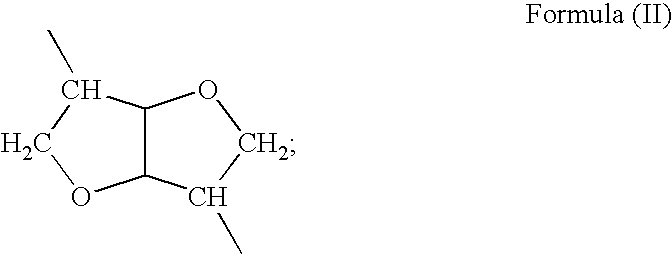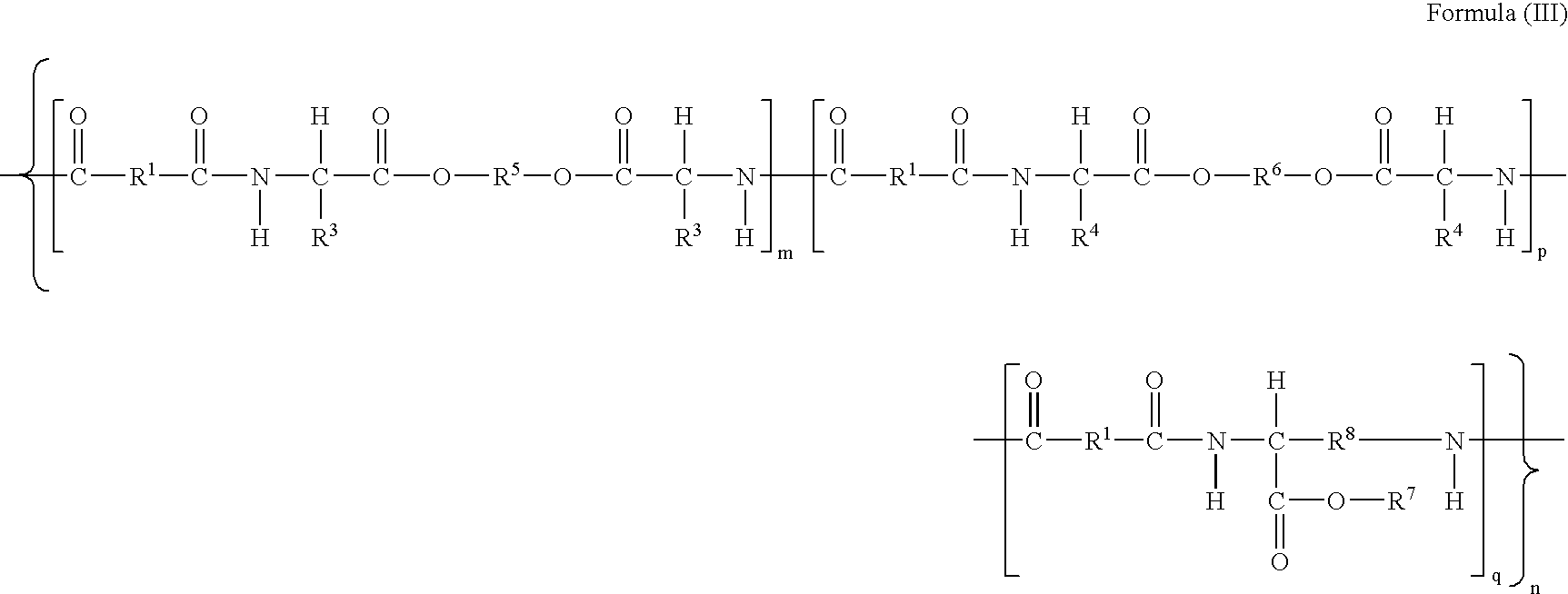Bis-(Alpha-Amino)-Diol-Diester-Containing Poly (Ester Amide) and Poly (Ester Urethane) Compositions and Methods of Use
- Summary
- Abstract
- Description
- Claims
- Application Information
AI Technical Summary
Benefits of technology
Problems solved by technology
Method used
Image
Examples
example 1
[0142]This example illustrates preparation of co-poly-4-[Leu(DAS)0.75-Leu(6)0.25] (Compound #2, of Table 1.), which is described by structural formula (I), wherein m=0.75, p=0.25, R═R2═(CH2)4, R3═R4=iso-butyl, R5═(CH2)6, and R6=formula (III).
[0143]Triethylamine (NEt3) (9.67 mL, 0.069 mole) was added to a mixture of di-p-toluenesulfonic acid salt of bis-(L-leucine)-1,4:3,6-dianhydrosorbitol diester (16.9577 g, 0.024 mole); di-p-toluenesulfonic acid salt of bis-(L-leucine)-1,6-hexylene diester (5.4320 g, 0.008 mole); and di-p-nitrophenyl adipate (12.2482 g, 0.032 mole) in dimethylformamide (DMF) (16.61 mL) (total volume of DMF and NEt3 is 26.28 mL, concentration of 1.2 mol / L by di-p-nitrophenyl adipate) at room temperature. Afterwards, the temperature was increased to about 80° C. and stirred for about 24 hours. The viscous reaction solution was cooled to room temperature, diluted with DMF (123.72 mL) (total volume of DMF and NEt3 is l 50 mL, concentration of 10% (w / v)). Acetic anhydr...
example 2
[0146]This example illustrates preparation of poly-4-[L-Leu(DAS)0.45-L-Leu(6)0.55] (Compound #3, of Table 1.), which is described by structural formula (I) wherein m=0.45, q=0.55, R1═R2═(CH2)4, R3═R4=iso-butyl, R5═(CH2)6, R6=formula (III).
[0147]Triethylamine (9.85 mL, 0.071 mole) was added to a mixture of di-p-toluenesulfonic acid salt of bis-(L-leucine)-1,4:3,6-dianhydrosorbitol diester (10.3574 g, 0.014 mole); di-p-toluenesulfonic acid salt of bis-(L-leucine)-1,6-hexylene diester (12.1651 g, 0.018 mole); and di-p-nitrophenyl adipate (12.4681 g, 0.032 mole) in DMF (16.91 mL) (total volume of DMF and NEt3 is 26.76 mL, concentration of 1.2 mol / L by di-p-nitrophenyl adipate) at room temperature. Afterwards, the temperature was increased to about 80° C. and stirred for about 24 hours. The viscous reaction solution was cooled to room temperature, diluted with DMF (123.24 mL) (total volume of DMF and NEt3 is 150 mL, concentration of 10% (w / v)). Acetic anhydride (0.567 mL, 0.006 mole) was...
example 3
[0149]This example illustrates preparation of poly-4-[L-Leu(DAS)0.20-L-Leu(6)0.80] (Compound #4, of Table 1.), which is described by structural formula (I), wherein m 0.20, q=0.80, R1═R2═(CH2)4, R3═R4=iso-butyl, R5═(CH2)6, R6=formula (III).
[0150]Triethylamine (9.99 mL, 0.072 mole) was added to a mixture of di-p-toluenesulfonic acid salt of bis-(L-leucine)-1,4:3,6-dianhydrosorbitol diester (4.6732 g, 0.007 mole); di-p-toluenesulfonic acid salt of bis-(L-leucine)-1,6-hexylene diester (17.9636 g, 0.026 mole); and di-p-nitrophenyl adipate (12.6576 g, 0.033 mole) in DMF (17.17 mL) (total volume of DMF and NEt3 is 27.16 mL, concentration of 1.2 mol / L by di-p-nitrophenyl adipate) at room temperature. Afterwards, the temperature was increased to about 80° C. and stirred for about 24 hours. The viscous reaction solution was cooled to room temperature, diluted with DMF (122.84 mL) (total volume of DMF and NEt3 is 150 mL, concentration of 10% (w / v)). Acetic anhydride (0.567 mL, 0.006 mole) was...
PUM
| Property | Measurement | Unit |
|---|---|---|
| Time | aaaaa | aaaaa |
| Time | aaaaa | aaaaa |
| Mass | aaaaa | aaaaa |
Abstract
Description
Claims
Application Information
 Login to View More
Login to View More - R&D
- Intellectual Property
- Life Sciences
- Materials
- Tech Scout
- Unparalleled Data Quality
- Higher Quality Content
- 60% Fewer Hallucinations
Browse by: Latest US Patents, China's latest patents, Technical Efficacy Thesaurus, Application Domain, Technology Topic, Popular Technical Reports.
© 2025 PatSnap. All rights reserved.Legal|Privacy policy|Modern Slavery Act Transparency Statement|Sitemap|About US| Contact US: help@patsnap.com



